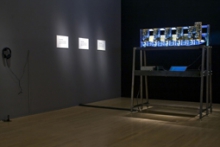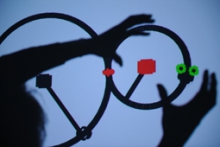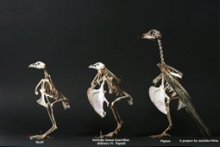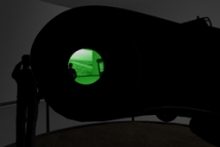Jurystament: transmediale Award 2009
Jurystament: transmediale Award 2009
The final list emerged from an in-depth critique of around 60 works pre-selected from over 1000 submitted projects. Our work involved establishing points of congruity and an ultimate consensus from a process of dialogue and, at times, lively debate. The festival theme is clearly apparent within several pieces on the list. However, we refused to over-prioritise this at the expense of other important considerations, such as the quality of the work, the concept, our intuition about how the work would function in the context of transmediale.09 and a desire to see the list reflect a mix of emerging and better-known artists.
Our foremost concern in the decision process was to balance a respect for artistic vision and imagination with a high quality of execution. We also agreed to respect the integrity of the works under consideration, as opposed to focussing on technique, media or genre. We felt it did not matter if the final list would be seen as 'high tech,' 'low-tech' or 'no-tech' as long as the work would be stimulating and remain memorable beyond the festival. A key word for us was 'experience.' By this we mean the experience of viewers, audiences, users and participants.
We sought to achieve a list that would appear topical – reflecting a multiplicity of perspectives on a complex and divergent world. The list combines levity with seriousness, analogue with digital and individual and group approaches to media. It also reflects a concern for the past and the future and for the combined use of new and old media to communicate contemporary ideas. It is worth noting that during the week of our selection meetings in October 2008 the world financial system appeared as close to collapse as it ever has during the past eighty years, and at times we sensed the cold draught of change coming through the open jury doors.
Harwood, Wright und Yokokoji
Tantalum Memorial
uk, 2008
Profound and dense, this work will be remade for transmediale after showings in 2008 in San Jose at 0l and in Italy at Manifesta7. It has been nominated for its quality of execution, density of imagination as well as conceptual and metaphorical strengths. It operates on many levels – casting light on the memory of the more than three million people who have died in wars in the Congo over the last ten years—through the use of telephony combined with computation. A rack of electromagnetic Strowger telephony switches is triggered by a computer that tracks calls from the 'Telephone Trottoire,' a 'social telephony' network designed for an international Congolese diaspora. This project builds on the Congolese practice of 'radio trottoire' – passing news and hearsay on street corners by word-of-mouth to avoid state control. Its imaginative breadth and its integration of socio-political objectives were seen by the jury as exceptional. The artists have established a substantial track record in engaging with subjects that impact us globally but are initially manifested locally, and their work is well-deserving of acknowledgement within transmediale 09.
Hiroshi Matoba
Overbug
jp, 2008
Overbug is a music-performance tool designed by Hiroshi Matoba to compose minimal and dance Music. Through looping and creating new sound pattern arrangements, called 'Bugsounds,' the program creates complex, polyrhythmic sound. We found it refreshing and amusing, entertaining and infectious. The circular and looped nature of its process appealed on a poetic level. Referencing the cyclical nature of time, nature and human life, it reminded us that as the world turns, it is the nature of things to change, decay and return. It is as simple as a wheel, a kind of demystifying and engaging joy-toy that brings us into the creative and artistic process. Arguably it is just a tool—a basic means of interaction and expression. In this sense, it is very much of today: a work of the 21st century, forged from software and computer code. A work that doesn't try to be sophisticated or conceptual; it just is what it is and does what it does. It makes you feel that you can join the collaboration, not just with other people but also with the system. If the world darkens and the ice melts, we feel there would still room for play and a bit of messing around.
Ewen Chardronnet and Bureau d'études
Laboratory Planet
fr, 2007, ongoing
This is a periodic journal produced by Bureau d'études, Ewen Chardronnet and a network of collaborators. It is part of a continuum of practice that is manifested in many different media. We liked the sense of urgency, the call for action, the polemic and design of the journal. The 'laboratory planet' concept is explored in texts enquiring into high technology, advanced science, laws and systems of control. Articles expose specific technologies and methods of scientific research developed in hidden spaces; others explore utopian or dystopian scenarios. Images and diagrams found in the journal could be from science fiction films or a gallery of the HQs of various Bond movie villains. As Michel Tibon-Cornillot writes in first issue: 'Is it really necessary to recall that the deepest sources of tyranny do not reside in the all too visible existence of coercion but in the accepted and internalised forgetting of other worlds, of those that have been engulfed but also those that are nonetheless still possible?' We saw Laboratory Planet – different in form from many proposals – as an important, unique and artist-led contribution to contemporary debate.
Rudolfo Quintas
Burning the Sound
pt, 2008
"Any sufficiently advanced technology is indistinguishable from magic." This quote by Arthur C. Clarke applies well to Burning the Sound, a performance by the young Portuguese artist Rudolfo Quintas, which combines high technology with one of the earliest tools used by humans – fire. Over thousands of years this element has not lost any of its magical, mesmerising qualities. Despite all our current knowledge, the behaviour of flames is still beyond our control and understanding. The performance amplifies this chaotic energy, taking us back in time to a moment when we would gather around a fireplace to witness the shamans. The custom software instrument developed by Quintas is so well designed that all of the high technology seems to disappear, bringing into focus the live performer and his skill in 'playing with fire.' The work is both compositional and performative, both technical and expressive. Quintas' own presence in the work draws the audience into the light of the flame and leads to a kind of exchange – a certain visual and physical ritual. The lighter functions as a kind of paintbrush that can carve out sounds from the air that the fire is constantly consuming.
Michiko Nitta
Extreme Green Guerrillas
uk, 2007
Highly topical and endowed with bizarre and endearing twists, this work by Michiko Nitta offers a number of tongue-in-cheek options for us to explore—nicely treading the fine line between irony and seriousness. The work draws attention to now-familiar themes of climate change, over-consumption and destructive ways of life. It proposes easy-to-do solutions, drawn from green approaches and eco-friendly lifestyles that are maybe accessible to us all. It suggests inventive remedies based on collaboration between high tech and green movements, which include actions and developments involving some of our roommates on this planet, such as marine mammals or birds. At first glance, all of this does seem extreme, but looking more closely we recognise the humour and absurdity of pushing supposedly 'good ideas' and 'good conscience' to their absolute limits. Our attempts to appreciate the seriousness of things might also lead us to develop a heightened sense of absurdity. As a jury we finally succumbed to the persuasive mix—the identification of the individual as the starting point for global solutions and the beautiful combination of high tech pseudo-design solutions with exquisitely old-fashioned ways.
Petko Dourmana
Post Global Warming Survival Kit
bg, 2008
Bulgarian born Petko Dourmana confronts us with an imagined post-apocalyptic landscape, inviting us to consider what it might be like to find ourselves alive in a 'nuclear winter.' He has fashioned a multimedia installation that endeavours to make us feel and visualise the situation—and not remain outside as casual visitors. We liked the idea that his 'survival kit' might offer hope beyond the prospect of global warming. It represents an artistic strategy which seems to fit neatly into the Deep North theme and to offer reflections on just how effective media arts strategies, tactical or otherwise, might be in such a domain. As with some of the other nominations, Dourmana also asked us to cast our minds back to history, to the industrial revolution and the shift from a handicraft-based to a machine-based culture, and to the position of Europe (and northern Europe in particular) as a generator of these shifts. Also like other works, this project straddles an ambiguity and tension relating to the issue of whether or not comfort can be found, somehow, in this period of change and adaptation. Through confrontation and action the work makes us stop and consider how far observation and contemplation might be able to take us at this point.
Perry Bard
Man With a Movie Camera: The Global Remake
us, 2007
This work takes a seminal idea from the past and turns it into contemporary practice. The idea is Vertov's famous silent film from 1929, in which he took a day in the life of the Soviet Union, made a documentary of the filming of the documentary and integrated the audience watching the film. Man With a Movie Camera: The Global Remake is a participatory video shot by people around the world who record images that interpret the original script and upload them onto a site that uses specially made software to archive, sequence and stream the submissions as a film: in the words of Perry Bard, a 'worldwide montage' and citing Vertov's terms, a 'decoding of life as it is.' Just as having access to a camera represented a new technology in 1929, the work uses the current state of the web today to deconstruct and recombine past and present in generating an open collaborative work. As a jury we felt that this project was nicely conceived, and although its method is not exceptional in its intentions or techniques, it has merit as a successful example of remix culture—which again reflects on the past and loops this very much into the present. We felt this genre of work deserved recognition within transmediale.
Reynold Reynolds
Six Apartments
de, 2007
Berlin-based artist Reynold Reynolds does not look to the past but brings us into an imminent future, a fictional future close enough to be understood as a strange dream or distorted reality involving the unsettling elements of plague, decay and disease, which firmly entrench the imagery of the work in our minds. We encounter the residents of Six Apartments and watch the diversity of their responses to growing contamination, whilst listening to news about an environmental crisis that is being broadcast into their homes. For some we feel empathy as they tidy their domestic spaces; others we watch descent into a gathering gloom. A sense of ambivalence and impending disaster is prevalent. Although this work shocks and appalls, it is also impressive by means of its dramatic colours and striking use of lighting that calls to mind a combination of past religious paintings and more recent horror film imagery. The result is grotesque yet compelling. As a dual screen video work, alluring and repellent, it impressed the jury as an example of employing the video medium to create a strong artistic effect. It is also a work that will offer a high quality of experience to audiences during the festival. Finally, the jury saw it fitting to recognise this fine video maker at a key stage in his career.








